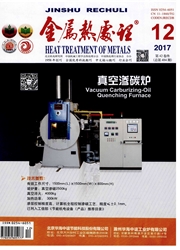

 中文摘要:
中文摘要:
900~1100℃淬火后,研究了250~600℃回火对高钒高速钢残留奥氏体转变及碳化钒析出的影响。结果表明:高钒高速钢的回火温度存在临界值(约450℃)。当回火温度低于临界值时,残留奥氏体含量变化不明显。当回火超过临界值后,随回火温度提高,残留奥氏体含量迅速降低。回火过程中碳化钒自残留奥氏体中析出是残留奥氏体转变的前提条件。碳化钒的析出取决于非平衡热力学条件,而其析出量在回火温度超过450℃后可根据平衡热力学估算。碳化钒的析出使得残留奥氏体向马氏体转变的相变驱动力大于临界相变驱动力,为残留奥氏体转变提供可能,但残留奥氏体的转变量主要取决于动力学因素。回火温度提高引起马氏体形核率呈指数提高,导致残留奥氏体含量迅速降低。
 英文摘要:
英文摘要:
Effects of tempering temperature on retained austenite transformation and VC precipitation of high-vanadium high-speed steel quenched at 900-1100 ℃ were investigated. The resuhs show there is a critical value (about 450 ℃ ) of tempering temperature. When the tempering temperature is lower than the critical value, the retained austenite content varies slightly. When the tempering temperature is higher than the critical value, the retained anstenite content decreases rapidly with the increase of tempering temperature. The precipitation of VC from retained austenite is a prerequisite for the transformation of retained austenite. Whether VC separate out from retained anstenite depends on nonequilibrium thermodynamics condition, but the amounts of precipitations can be evaluated according to the equilibrium thermodynamics when the tempering temperature is higher than 450 ℃. VC precipitation makes the phase transformation driving force from retained austenite to martensite be bigger than the critical value, which provides possibility of retained austenite transformation. However, the amount of retained austenite transformation mainly depends on the dynamics conditions. When the tempering temperature is higher than 450 ℃, the nucleation rate of martensite exponentially increases with increasing tempering temperature, which leads to rapidly decrease of retained austenite content.
 同期刊论文项目
同期刊论文项目
 同项目期刊论文
同项目期刊论文
 Effects of carbon content and sliding ratio on wear behavior of high-vanadium high-speed steel (HVHS
Effects of carbon content and sliding ratio on wear behavior of high-vanadium high-speed steel (HVHS 期刊信息
期刊信息
